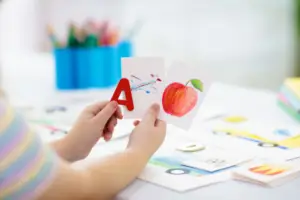It is important to groom your child on the basics of reading and writing even before they start a conventional school. This article which contains information on Emergent Reading and Writing, will expose you to the concepts and how you can go about teaching your child how to read and write.

Have you ever seen a child who struggle to read and write at the age of 12? When you saw that did you attribute it to some sort of spiritual problem? If you did, well permit me to burst your bubbles, there is a great probability that it’s neither spiritual nor health challenge. Oftentimes, it is the fault of parents and guardians.
The mistake a lot of parents make is not making attempts to start teaching their toddlers way before they start a formal school. As a parent, it is your responsibility at this phase to ensure your child has a strong foundation.
Learning to read begins before birth. That sounds odd right? At least when my mum was pregnant with my last sibling, a few times I heard her speak to the baby whenever he kicked profusely and he always calmed down like he actually heard her. Maybe he did hear her.
Well, babies cannot read at a certain stage but the neural and behavioral [2] foundations for later reading are put into place before formal instruction in school begins. This is why parents who understand this concept get worried when at a certain age their babies are yet to say their first words which oftentimes is Dada or Mama (Daddy and Mummy).
One of the key insights from the science of learning is that students build on prior knowledge. In order words, whatever learning foundation you lay for them at a very tender age is what they build on once they start a formal education. Where there is no proper foundation, they struggle to learn to read and write when they eventually start school.
This brings us to the focus of the article which is emergent reading and writing.
What is Emergent Literacy?
Emergent literacy [3] is a term used to describe the foundation for learning to read. It is “the skills, knowledge, and attitudes that are developmental precursors to reading and writing.”
Emergent literacy can also be defined as a set of skills that children develop before they start to read and write. This stage of learning takes place from birth through the preschool years. During this phase, children start to understand that printed words carry meaning and begin to recognize letters, sounds, and words. It serves as the foundation for future reading and writing skills.
Therefore, it is important for children to have these foundational skills before they begin to read and write. By incorporating these simple emergent literacy skills into your reading routine, you’re helping to set your child up for reading success in future.
Emergent literacy skills develop naturally in a supportive and language-rich environment, where children are exposed to various forms of print and engage in meaningful interactions with adults and peers. It doesn’t matter if they are still toddlers, just expose them to reading as though they understood.
Components to Emergent Literacy
The skills, knowledge, and attitudes that are developmental requirements for learning to read and write involves many components, including:

1. Letter Knowledge
This is one of the earliest predictors of early word reading and is a huge component of literacy skills. Here, you can start by drawing your child’s attention to the letters in their own name.
Point out letters in books. Doing this helps modify the neural visual processing systems of the child.
2. Print Knowledge
You can help develop your child’s early literacy skills through print knowledge by doing the following:
- drawing attention to the print while reading.
- saying or pointing to highlight the print in the book!
- teaching your child to read from left to right, top to bottom. For instance, while reading, you can say things such as “I am going to start reading here at the top”- you can drag your finger along as you read to teach the child the direction in which we read, etc.
3. Dialogic Reading

This simply means having a conversation with your child while you’re reading together. Reading should be an interactive experience that involves storytelling, asking and answering questions, and making comments.
Don’t worry about reading all the words on the page. You can tell a different story by using the pictures rather than the text. Wordless picture books work great too!
Allow your child to be the storyteller while you listen and answer questions.
4. Phonological Awareness
This component helps them become sensitive to the sound structure of spoken language.
You can read rhyming books with your kids or play rhyme games. You can use words targeting alliteration that repeats the same sound(s) throughout the book
Example: Father Friday Fried Five Fresh Fish.
What is Emergent Reading?
Emergent reading [1] involves the development of pre-reading skills that lay the groundwork for reading comprehension. These skills include:
1. Print Awareness:
Children begin to understand that printed words convey meaning and that text is read from left to right and top to bottom. They learn to differentiate between letters, words, and sentences and recognize the features of books, such as the front cover, title, and illustrations.
2. Phonological Awareness:
This refers to the ability to hear and manipulate the sounds of language. Children develop phonological awareness by recognizing and playing with rhymes, syllables, and individual sounds. They may practice activities like clapping out syllables or identifying words that rhyme.
3. Letter Recognition:

Children gradually learn to recognize and name letters of the alphabet. They understand that letters represent specific sounds and can identify letters in their environment, such as on signs, labels, or in books.
4. Vocabulary Development:
Building a strong vocabulary is crucial for reading comprehension. During emergent reading, children expand their vocabulary by listening to stories, engaging in conversations, and exploring new words in context.
What is Emergent Writing?
Emergent writing involves the development of pre-writing skills that lay the foundation for writing proficiency in future. These skills include:
1. Scribbling and Drawing:
In the early stages, children experiment with making marks on paper, eventually progressing to purposeful scribbling. They gain control over writing tools and use them to represent objects or ideas. Growing up, we all did this. My mum never stops talking about how I condemned her books and bags scribbling things. Today, guess who’s a writer? (Smiles)
2. Letter Formation:
Children start attempting to form letters, often beginning with the letters in their name. They may use letter-like shapes or random combinations of lines and curves to represent letters.
3. Phonemic Awareness:
Similar to emergent reading, phonemic awareness plays a role in emergent writing as well. Children begin to relate sounds with letters and attempt to represent the sounds they hear in words.
4. Environmental Print:
Children make connections between written words and their environment. They recognize and attempt to write familiar words, such as their name, favorite foods, or labels on household items.
5. Storytelling and Dictation:
Children engage in storytelling, either orally or through dictation. They begin to understand the structure of narratives, express ideas.
6. Writing Conventions:
As emergent writers gain exposure to printed text, they begin to understand basic writing conventions such as using spaces between words, capitalizing the first letter of a sentence, and using punctuation marks.
Ways To Enhance Emergent Reading and Writing:
To support the development of emergent reading and writing skills, parents, caregivers, and educators can employ various strategies:
1. Read Aloud:
Reading aloud regularly can expose children to a variety of texts, vocabulary, and language patterns. It enhances listening skills, comprehension, and a love for reading.
2. Shared Reading:
Engage children in shared reading experiences, where they can actively participate by questioning, and discussing the text. Point out letters, words, and text features to promote print awareness.
Conclusion
Emergent reading and writing are crucial stages in a child’s literacy development. During this phase, children begin to acquire the foundational skills necessary for successful reading and writing later in life. Emergent reading involves print awareness, phonological awareness, letter recognition, vocabulary development, and basic comprehension strategies.
On the other hand, emergent writing encompasses scribbling, letter formation, phonemic awareness, environmental print, storytelling, and the understanding of writing.
Supporting children’s emergent reading and writing skills requires a language-rich environment that provides exposure to various forms of print and meaningful interactions with adults and peers.
Strategies such as read-aloud sessions, shared reading experiences, word play, and phonemic awareness activities play a vital role in nurturing these skills. By engaging children in these activities and creating opportunities for exploration and expression, caregivers and educators can help foster a strong foundation for future reading and writing success.
It is important to note that children progress through emergent reading and writing at their own pace, and there may be individual variations in their development. Patience, encouragement, and a supportive environment are key factors in promoting their growth. By recognizing and valuing the emergent literacy skills children possess, we can empower them to become confident and proficient readers and writers in the future, setting them on a path towards lifelong learning and communication.
So, as a parent, don’t wait to enroll your child in a formal school before you start grooming them. It’s always important to catch them young. You don’t need a pro teaching experience to be able to help your child build these skills.
References
[1] “Emergent Literacy.” ECLKC, 7 June 2019, https://eclkc.ohs.acf.hhs.gov/school-readiness/home-visitors-online-handbook/emergent-literacy.
[2] “Emergent Literacy: Building a Foundation for Learning to Read.” IBE — Science of Learning Portal, UNESCO International Bureau of Education, 8 Dec. 2021, https://solportal.ibe-unesco.org/articles/emergent-literacy-building-a-foundation-for-learning-to-read/.
[3] Mignone, Alyssa. “Emergent Literacy: Early Skills to Help Your Child Develop.” NAPA, NAPA Center, 17 Oct. 2022, https://napacenter.org/emergent-literacy.
Don’t miss out on current updates, kindly like us on Facebook & follow us on Follow @EAfinder OR leave a comment below for further inquiries.






